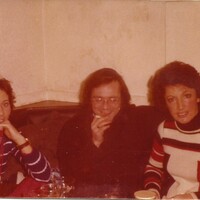 Dorothy Fox, Bríd Carr, Michael Conlon
Dorothy Fox, Bríd Carr, Michael Conlon Members of administrative staff, Dorothy Fox (extreme right), Bríd Carr and Michael Conlon, relaxing with drinks in a lounge
 Brian Leonard
Brian Leonard 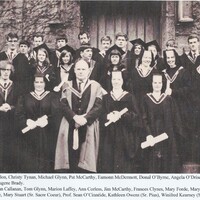 Science Graduation Class, 1968
Science Graduation Class, 1968 This is the occasion of the Science B.Sc. graduation in Nov. 1968. Prof. Seán Ó'Cinnéide, Professor of Inorganic Chemistry (1965-1988) is in the centre of the front row in the accompanting picture.
Names of the B.Sc. graduates in the picture are given below:
Back Row (l-r): Joe Scanlon, Christy Tynan, Michael Glynn, Pat McCarthy, Eamonn McDermott, Donal O’Byrne, Angela O’Driscoll, Anna Dillon, Eamonn Ryan, John O’Connor, Eugene Brady.
Middle Row (l-r): Brendan Callanan, Tom Glynn, Marion Laffey, Ann Corless, Jim McCarthy, Frances Clynes, Mary Forde, Mary Corr, Tom Warner
Front row (l-r): Terry Lee, Mary Stuart (Sr. Sacre Coeur), Prof. Sean O’Cinnéide, Kathleen Owens (Sr. Pius), Winifred Kearney (Sr. Raphael)
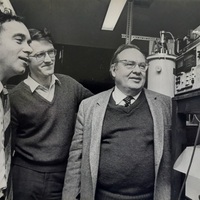 Visit of Nobel Laureate, Arthur Schawlow
Visit of Nobel Laureate, Arthur Schawlow Arthur (Art) Schawlow visited the Spectroscopy Group, Department of Experimental Physics at University College Galway in July 1986. Art developed the theoretical basis for lasers along with Charles Townes. Arthur Schawlow shared the Nobel Prize in Physics in 1981, (Wikipedia, June, 2024).
The picture shows (l-r): Frank Imbusch, Tom Glynn and Art Schawlow in the Spectroscopy Laboratory at University College Galway.
 Sean Lavelle & Experimental Medicine
Sean Lavelle & Experimental Medicine John (Sean) M. Lavelle was appointed Professor at University College Galway in 1959 (University Calendar, 2005-06). A new Department of Experimental Medicine and Practical Pharmacology was established in 1960, with Sean Lavelle as Professor. It was considered innovative at the time especially in the application of computers in clinical problem solving and research methods (Murray, 1999, p.153). Research work, especially into computer-aided diagnostic programmes was conducted with clinical departments in local hospitals and / or clinical centres throughout Europe (Murray, 1999, p.156). An example of such collaboration was the EURICTERUS Project Management Group which focussed on clinical presentation of jaundice in Europe, with Sean Lavelle & his research group being the University of Galway partner.
That particular Project was part of the European Commission 4th Medical Research and Development Coordination Programme. The Project was operational between 1st Jan 1988 and 31 Jan 1992. Local Project personnel were Joan Kavanagh, Research Assistant, and Ben Kanagaratnam, Computer Programmes. A trip to the Burren National Park was organised during a Project Meeting at University College Galway in Apr. 1991. Group participants included: Local participants Sean Lavelle & Joan Kavanagh; as well as R. Cozzolongo, Ospedale Specializ in Gastroenterologia, Castellana Grotte, Italy.
The first picture shows Sean Lavelle within the confines of the Poulnabrone dolmen in the Burren National Park.
The second picture shows the Burren Trip Group with Sean Lavelle at the extreme left in the front row and Joan Kavanagh (in pink outfit) also in the front row.
Sean retired in 1993 and he passed away on 2 Jan. 2016.
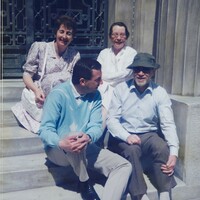 A Medical Group Gathering, 1989-1991
A Medical Group Gathering, 1989-1991 Sean Lavelle, Dept. of Experimental Medicine (on the right of the picture) is sitting on steps alongside Parnell Keeling , Dept. of Surgery. At the rear is Joan Kavanagh (left of picture), Research Assistant, Dept. of Experimental Medicine alongside Frances Lavelle, wife of Sean Lavelle.
Parnell Keeling was appointed Lecturer in Surgery in 1989 and he resigned in 1991, and then went to the Royal College of Surgeons in Ireland (RCSI).
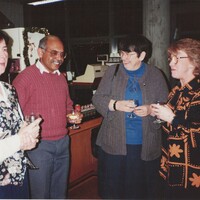 A Medical Christmas Party
A Medical Christmas Party The pictures show members of the Medical Faculty having a Christmas Party.
Picture 1 shows four people (l-r): Una O'Connor, Dept. of Medicine; Benjamin (Ben) Kanagaratnam, Computer Programmer, Experimental Medicine; Dr. Fiona Stevens, Gastroenterologist, Dept. of Medicine; and Rosaleen Carroll, Medical Faculty Administrator.
Picture 2 shows six women (l-r): Rosaleen Carroll; Joan Kavanagh, Research Assistant, Experimental Medicine: Debbie Munro, Paediatric Administrator; Marian Fannon, Psychiatry Administrator; Máire Joyce, Dean's Office; Máire Mhic Íomhair, Experimental Medicine
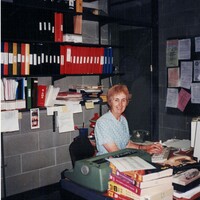 Department of Experimental Medicine Personnel
Department of Experimental Medicine Personnel Personnel, mainly from the Department of Experimental Medicine, are shown in accompanying pictures. First shown is Joan Kavanagh, Research Assistant, in an office near the Experimental Medicine laboratory in the Clinical Sciences Institute Building, which was opened in 1992. The second picture shows Máire Mhic Íomhair, Technician and later Senior Technician, in the Experimental Medicine Laboratory which was then housed in a prefabricated building in University grounds across from Newcastle Post Office.
A third picture shows a group of people in an Experimental Medicine room.
Present were (l-r): Daniel (Danny) Kerr, Senior Technician, Dept. of Pharmacology; Nicholas Donohue, Senior Technician, Experimental Medicine; Prof. Sean Lavelle, Dept. of Experimental Medicine; Joan Kavanagh; Aileen Glynn; Máire Mhic Íomhair; Dr. Rory Comerford, Dept. of Experimental Medicine; and Benjamin (Ben) Kanagaratnam, Senior Technician, Dept. of Experimental Medicine
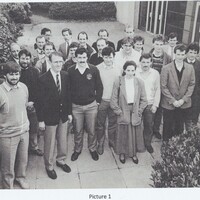 Reaching out to Industry
Reaching out to Industry Primarily an academic institution, focused on teaching and on original research, staff from University College Galway (UCG), now known as University of Galway, began to provide other courses to industries and to other personnel in the mid-1980’s. The Department of Experimental Physics was a leader in this area of activity. The first courses were on Microprocessors (run by Drs Redfern, Martin, and Larkin), followed by courses on Industrial Hygiene and Occupational Health (Dr Tom O’Connor). Beginning in 1988, courses on Lasers and Applications and on Laser Safety were provided by Drs Glynn, Morgan, and Redfern, and these courses were subsequently taken up by the National Centre for Laser Applications (NCLA) established in 1989 in the Department of Physics. Over the following years, the Lasers & Applications course was run on an annual basis and a Laser Safety course was run several times for many years as local industry, particularly the medical device industries, began to increase their use of lasers in product manufacturing and in quality control and monitoring. With increasing use of laser technology in hospitals, medical personnel also attended the courses on laser safety, with an increasing use of laser technology in hospitals.
Picture 1 shows a picture of attendees at a Lasers and Applications course on 3-4 April 1989, taken outside the University restaurant. Attendees were from industries in Galway, Clare and Limerick. Dr T.J. Glynn (Dept. of Experimental Physics) is second from left in the front row and Dr G.P. Morgan (Dept. of Experimental Physics) is second from left in the second row.
Picture 2 shows a picture of attendees at a Lasers and Applications course on 23-24 April 1990, taken on the steps of the Aula Maxima in the Quadrangle. Attendees were from industries located in Galway, Limerick, Louth, Waterford, and from Ayr in Scotland. Dr G.P. Morgan is on the extreme left in the back row and Dr T.J. Glynn is second from left in the front row.
 High power lasers come to the University of Galway
High power lasers come to the University of Galway The first laser, using the gemstone ruby as active medium, was operated in 1960. Since then, lasers of increasing power and operating at many different wavelengths have been developed, by using other materials either in solid, liquid, or gaseous forms. In the intervening period, they have transformed the way in which we live, work and play. Using a research grant from EOLAS in 1977, Dr Tom Glynn bought the first high power laser, a gas-based argon laser, for the spectroscopy group in the Dept. of Experimental Physics. After a sabbatical research period in the U.S. in 1982/83, he added a tunable laser, based on a flowing dye solution, which was driven by the argon laser. By selecting the appropriate dye, the wavelength of operation could be tuned over a wide range and was the perfect tool for investigating the spectroscopy of a wide range of materials.
Picture 1 shows Dr Glynn adjusting the output of the red beam of the dye laser in the foreground, which is being driven by the green beam of the argon laser in the background. This system was a valuable and effective tool in the research of several Ph.D students over the following years. By 1989, Dr Glynn had developed an interest in lasers of higher power which could be used in industry for cutting, welding, drilling, marking, and lots of other applications. This led to the setting up of the National Centre for Laser Applications (NCLA), assisted by a strategic research grant from EOLAS (a fore-runner of Enterprise Ireland).
Within a 10-year period, the centre had assembled the largest collection of industrial lasers and diagnostic equipment within third level institutions in Ireland and was working with multinational and national companies on research and development projects. Much of its work was on behalf of multinational medical device companies, many of them in the west of Ireland.
Picture 2 was taken during a visit to the NCLA laboratories by the Minister of State for Science & Technology, Mr Michael Ahern in 1992.
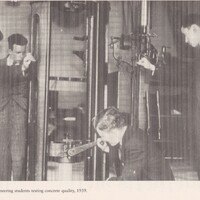 Testing concrete quality in 1939
Testing concrete quality in 1939 The picture shows four engineering students testing concrete in the Engineering Laboratory in 1939 (NUI Galway Staff Book, 2000 – 2001)
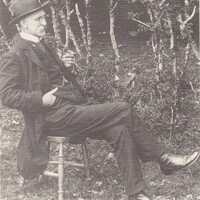 Seaghan Mac Énrí
Seaghan Mac Énrí The picture shows Seaghan (Seán) Mac Énrí , dressed smartly, wearing a hat, and sitting on a chair with small sized trees in the background (NUI Galway Staff Book, 2000 – 2001). He was appointed Professor of Opthalmology and Otology and Lecturer in Modern Irish [Ollamh le hOftailmeolaíocht agus Oiteolaíocht, agus Léachtóir le Nua-Ghaeilge] in 1910 (General Calendar, 2005 - 2006). He died in 1930.
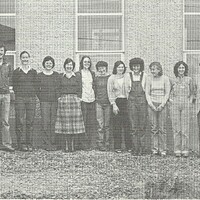 Cúrsa Gaeilge agus Riaracháin in Áras Mháirtín Uí Chadhain, 1979/ Irish-language and Administration course in Áras Mháirtín Uí Chadhain, 1979
Cúrsa Gaeilge agus Riaracháin in Áras Mháirtín Uí Chadhain, 1979/ Irish-language and Administration course in Áras Mháirtín Uí Chadhain, 1979 Baill den lucht Riaracháin ag freastal ar bhonn deonach ar chúrsa Gaeilge agus Riaracháin in Áras Mháirtín Uí Chadhain, An Cheathrú Rua, i 1979. / Members of Administrative staff attending on a voluntary basis an Irish-language and Administration course in Áras Mháirtín Uí Chadhain, An Cheathrú Rua, in 1979.
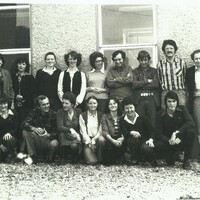 Cúrsa Gaeilge do Lucht Riaracháin agus eile, Áras Mháirtín Uí Chadhain, deireadh na 1970idí / Irish-language course for Administrative Staff and others, Áras Mháirtín Uí Chadhain, late 1970s
Cúrsa Gaeilge do Lucht Riaracháin agus eile, Áras Mháirtín Uí Chadhain, deireadh na 1970idí / Irish-language course for Administrative Staff and others, Áras Mháirtín Uí Chadhain, late 1970s Grúpa d'fhoireann riaracháin na hOllscoile, ón Leabharlann go háirithe, móide roinnt mac léinn a d'fhreastail ar bhonn deonach ar chúrsa Gaeilge in Áras Mháirtín Uí Chadhain ag deireadh na 1970idí. / A group of administrative staff of the University, mostly from the Library, and some students who attended an Irish-language course in Áras Mháirtín Uí Chadhain in the late 1970s.
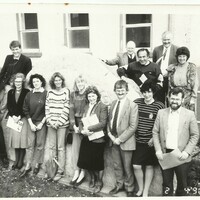 Cúrsa Gaeilge do Mhic Léinn in Áras Mháirtín Uí Chadhain, 1990 /
Irish-language Course for Students in Áras Mháirtín Uí Chadhain, 1990
Cúrsa Gaeilge do Mhic Léinn in Áras Mháirtín Uí Chadhain, 1990 /
Irish-language Course for Students in Áras Mháirtín Uí Chadhain, 1990 Grúpa mac léinn ag freastal ar chúrsa Gaeilge in Áras Mháirtín Uí Chadhain, An Cheathrú Rua, in Aibreán 1990. / Group of students attending an Irish-language course in Áras Mháirtín Uí Chadhain, An Cheathrú Rua, in April 1990.
 NUI Honorary Degree Conferring in UCG, 1995
NUI Honorary Degree Conferring in UCG, 1995 Group photograph of four recipients of honorary doctorates from the NUI, together with the Chancellor of the NUI and the President of UCG, at the conferring of those degrees in UCG by the Chancellor on June 26, 1995. Those recipients and the degree conferred on each were as follows: Michael J. Roarty (LLD ), Archbishop Wilfrid F. Napier (LLD), Nicholas Robinson (LLD) and Seán Ó Lúing (DLittCelt).
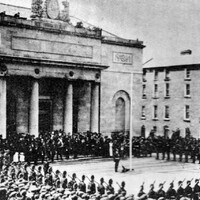 Galway Courthouse 1910, King George V Proclamation
Galway Courthouse 1910, King George V Proclamation The accession of King George V to the throne was proclaimed in Galway Courthouse at 2 pm on 21 May, 1910, following the death of Edward VII. The ceremony was performed by the High Sherriff, Mr. Cecil R. Henry (www.kennys.ie, 2016). A picture shows the scene outside of Galway Courthouse (Semple, 1969). About one hundred men of the Connaught Rangers, under Major Sarsfield, were formed up in line opposite the Courthouse, and an equal number of the Royal Irish Constabulary (www.kennys.ie, 2016), whose bayonets are shouldered, and under the command of the Head Constable, Charles Carlos. Family tradition (P. Larkin, personal communication) has it that the two white figures at the base of the Courthouse steps in the picture were likely Charles Carloss’ daughters – Rita and Nina Carlos. Their confirmation picture in about 1910-12, with Rita on the left, is also shown. That picture was taken In Slater's Studio, Ballina, Co. Mayo in the period between 1910 - 12, (P. Larkin, Personal communication).
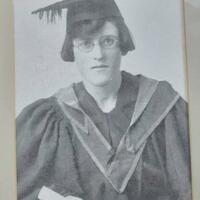 Bridget Agnes Barrett, Graduation in 1926
Bridget Agnes Barrett, Graduation in 1926 Bridget Agnes Barrett was born in 1905 in Glencastle, Belmullet, Co. Mayo. She spent three years at second level in the Loreta Convent, Mullingar and went to University College Galway in 1924. She obtained a B. Comm. Degree in 1926 and she also studied French & German. This was followed by a 2nd Class Honours in the Higher Diploma in Education in 1927. She then spent a year at Carysfort Teacher Training College in Blackrock, Co. Dublin, being educated there as a primary school teacher. She taught in Belmullet National School and became principal there. She married Dr. Thomas Kelly on 2 Feb 1931 and they had six children including Joseph (Joe) M. and Rosaleen. Bridget passed away in 1995.
Joseph (Joe) M. Kelly was appointed Lecturer in Surgery (Orthopaedics) at University College Galway in 1984 and he retired in 1998. He passed away on 28 May 2019.
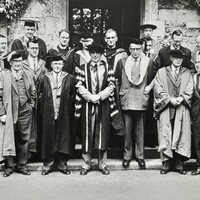 The President and academic colleagues on the occasion of a conferring
The President and academic colleagues on the occasion of a conferring The picture shows the President of UCG, Dr Martin J. Newell (third from left in front row) with academic colleagues on the occasion of a degree conferring.
Back row (l-r): Colm Ó hEocha; Patrick Larkin (with hat); Déaglán Ó Caoimh; Revd Fr Eustás Ó hÉideáin; Margaret Shea; Revd Fr Edwin Rabbitte; Seán Tobin; man with hat, unidentified; Edward O’Dwyer; Michael Duignan.
Front row (l-r): Jeremiah Murphy; Cilian Ó Brolcháin; Martin Newell; James Mitchell; Stephen Shea; Seaghan Ó Beirn.
Colm Ó hEocha was Lecturer in Chemistry (1955-63); Prof. of Biochemistry (1963-75); President (1975-96).
Patrick Larkin was Prof. of Education (1925-67); Bursar (1946-65).
Déaglán Ó Caoimh was Prof.of Civil Engineering (1958-1996); Registrar (1980-86).
Revd Fr Eustás Ó hÉideáin was Lecturer in Philosophy (1959-1968); Prof. of Education (1968-87).
Margaret (Peggy) [Cooke] Shea was Prof. of German (1921-65). Margaret Cooke (8 Dec 1895–15 Apr 1981) from Carrigeenagowna, Tubbercurry, Co. Sligo married Stephen Shea on 3 January 1925 [www.irishgenealogy.ie]. They had five children.
Revd Fr Edwin Rabbitte was Prof. of Philosophy (1958-85).
Seán S. Tóibín was Lecturer in Mathematics (1956-61); Prof. of Mathematics (1961-95).
Edward N. (Eamon) O’Dwyer was Prof. of Obstetrics and Gynaecology (1958-1989).
Michael V. Duignan (1907- 1988) held the Chair of Celtic Archaeology in UCG from 1945 to his retirement in 1977. He was Dean of the Faculty of Arts (1965-70); Registrar (1970-74), and Acting President, Sept. to Dec. 1975.
Jeremiah Murphy was Prof. of English Language and English Literature (1934-1965).
Cilian Ó Brolcháin was Prof. of Experimental Physics (1934-1973).
Martin J. Newell was Lecturer in Mathematics (1935-55); Prof. of Mathematics (1955-1960); President (1960-1975).
James Mitchell was Prof. of Geology and Mineralogy (1921-1966); Registrar and Secretary (1934-66).
Stephen Shea (1 Feb 1897–16 Nov 1980) was Prof. of Anatomy (1921-67). He was also Dean of the Medical Faculty. He married Margaret Cooke [www.findagrave.com].
Seaghan Ó Beirn was Prof. of Surgery (1957-79).